2016 Honda Civic Sedan Research - Powertrain Specs, Features and Details
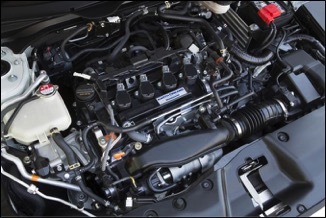 |
Oct 18, 2015, With two advanced new engines and new and updated manual and Continuously Variable Transmissions, the 2016 Civic offers a range of new powertrain choices that combine fuel efficiency and fun-to-drive performance.
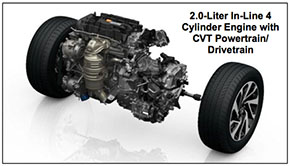
The all-new base engine is a 2.0-liter 16-Valve DOHC i-VTEC® that is related to the 2.4-liter engine offered in the larger Accord. With its larger displacement (replacing Civic's previous SOHC 1.8-liter engine) it offers more horsepower and torque than any previous base Civic engine in the U.S. The new 2.0-liter engine is rated at 158 horsepower at 6500 rpm1 and 138 lb-ft. of torque at 4200 rpm2 (an increase of 15 horsepower and 9 lb-ft. of torque). The 2.0-liter engine is paired with a new 6-speed manual transmission (LX) or a Continuously Variable Transmission (CVT) for efficient automatic operation.

For drivers looking for even greater performance coupled with equally high EPA fuel economy ratings, for the first time ever, the Civic is available with a turbocharged engine. The 1.5-liter 16-valve DOHC direct-injected turbocharged powerplant is rated at 174 horsepower at 5500 rpm3 with torque output an impressive 162 lb-ft. of torque between 1,800 and 5,500 rpm4.
Both engines are LEV3-ULEV125/LEV3-SULEV 30 emissions compliant.5 The new, more efficient engines and transmissions, along with improved aerodynamics and a major reduction in running resistance, result in substantially enhanced performance and fuel efficiency. Compared to the previous Civic 1.8-liter with either manual transmission or CVT, anticipated EPA highway fuel economy ratings6 are up across the board:
- +4 mpg on 2.0-liter with 6MT to 40
- +2 mpg on 2.0-liter with CVT to 41
- +3 mpg on 1.5-liter Turbo with CVT to 42
Key Powertrain Features
Engines
- New 2.0-liter, DOHC inline-4 engine*
- 158 horsepower at 6500 rpm (SAE net)1
- 138 lb-ft. torque at 4200 rpm (SAE net)2
- i-VTEC® (intelligent Variable Valve Timing and Lift Electronic Control) with dual VTC (Variable Valve Timing Control)
- Programmed Fuel Injection (PGM-FI)
- 10.8:1 compression ratio
- Lightweight, high rigidity steel crankshaft
- Drive-by-Wire throttle system
- Port injection system
- Maintenance Minder™ system optimizes service intervals
- 100,000 +/- miles tune-up interval7
- New turbocharged 1.5-liter, DOHC direct-injected inline-4 engine*
- 174 horsepower at 5500 rpm (SAE net)3
- 162 lb-ft. torque at 1,800-5,000 rpm (SAE net)4
- Dual VTC (Variable Valve Timing Control)
- Low inertia Mono scroll turbo system*
- Computer-controlled Direct Injection (DI) with multi-hole fuel injectors*
- 10.6:1 compression ratio
- Lightweight, high rigidity steel crankshaft
- Drive-by-Wire throttle system
- Maintenance Minder™ system optimizes service intervals
- 100,000 +/- miles tune-up interval7
Emissions/Fuel Economy Ratings
- LEV3-ULEV125/LEV3-SULEV30 Emissions compliant5
- Improved U.S. EPA fuel-economy ratings (city/highway/combined)
(anticipated)
- 27/40/31 mpg6 (2.0-liter with 6MT)
- 31/41/35 mpg6 (2.0-liter with CVT)
- 31/42/35 mpg6 (1.5-liter turbo with CVT)
Transmissions
- 6-speed Manual (2.0-liter)
- Continuously Variable Transmission (2.0-liter)
- Continuously Variable Transmission (1.5-liter turbo)
* First for Civic
Engine Architecture and Features
2.0-Liter In-Line 4 Cylinder
Related to the
European Civic Type-R 2.0 liter turbo charged engine, the Civic's new
standard 2.0-liter i-VTEC powerplant produces more horsepower and
torque at all operating speeds compared to the 1.8-liter engine it
replaces. The new engine also is anticipated to help the Civic receive
superior EPA MPG ratings.6 The new 2.0-liter engine is rated at
158 horsepower at 6,500 rpm1 and 138 lb-ft. of torque at 4,200
rpm.2 The anticipated EPA fuel economy rating is 27/40/31
mpg6 city/highway/combined with 6-speed manual transmission, and
31/41/35 mpg6 with CVT.

Cylinder Block and Crankshaft
The Civic's new
2.0-liter inline four has a lightweight die-cast aluminum block with a
bedplate main-bearing design that creates a rigid assembly to help minimize
noise and vibration. Cast-in iron cylinder liners provide long-lasting
durability. Thin slits between each adjacent cylinder sleeve help improve
engine cooling and knocking.
Each journal on the lightweight heat-forged steel crankshaft is micropolished to reduce internal friction and improve smoothness throughout the rpm range and help lower noise levels.
Pistons/Connecting Rods
Designed with
"cavity-shaped" crowns, the 2016 Civic's pistons help maintain stable
combustion and contribute to improved efficiency. To reduce weight,
minimize vibration and increase operating efficiency, the lightweight
pistons have a carefully optimized skirt design. Ion-plated piston rings
help reduce friction for greater operating efficiency. Heavy-duty steel
connecting rods with tapered small ends are heat-forged in one piece and
then "crack separated" to create lighter and stronger rods with an
optimally fitted bearing cap.
Cylinder Head and i-VTEC Valvetrain
The
Civic's 2.0-liter 4-cylinder engine has a lightweight DOHC cylinder head
that is made of low-pressure casted aluminum alloy. With exhaust-port
passages cast directly into the cylinder head, the need for a traditional
separate exhaust manifold is eliminated.
A low-friction silent-chain drives dual overhead cams and four valves per cylinder. The cam drive is maintenance free throughout the life of the engine. To help further reduce friction, the finish of the camshaft journals has been improved. To improve cooling and detonation resistance, the cylinder head has a cooling passage placed between each pair of exhaust valves.
To help boost fuel efficiency and power, the combustion chamber shape and valve angles have been optimized. The included valve angle is 35 degrees, to decrease the surface-to-volume ratio of the combustion chambers and help create a flatter, more compact combustion chamber that reduces unburned hydrocarbon emissions. With this new combustion chamber shape, the compression ratio has been increased to 10.8:1 (up from 10.6:1 on the previous 1.8-liter engine), yet the engine still operates on regular unleaded fuel.
The cylinder head features a new high-tumble intake-port design. In combination with the new combustion chamber and piston crown shape, the design's high level of airflow tumble helps create a homogenous fuel mixture for low fuel consumption and high airflow for high power output.
The Civic's 2.0-liter DOHC 16-valve i-VTEC® engine uses an advanced valve control system to combine high power output with high fuel efficiency and low emissions. The system combines dual VTC (Variable Valve Timing Control), which continuously adjusts the intake and exhaust camshaft phase, with Variable Valve Timing and Lift Electronic Control (VTEC), which changes valve lift, timing and duration of the intake valves.
The "intelligent" portion of the system is its ability to continuously vary the timing of the intake and exhaust camshafts using variable valve timing control (VTC). This helps increase power and also provides a smoother idle (allowing idle speed to be reduced). The cam timing is varied based on input from sensors that monitor rpm, timing, throttle opening, cam position and exhaust air-fuel ratio. The result is increased fuel efficiency and lower emissions. Under certain conditions, the VTC can hold the intake valves open longer to allow a reverse airflow of intake air into the intake manifold.
Programmed Fuel Injection (PGM-FI)
The 2.0-liter
engine's Programmed Fuel Injection (PGM-FI) continually adjusts fuel
delivery to yield the best combination of power, low fuel consumption and
low emissions. Multiple sensors constantly monitor critical operating
parameters, such as throttle position, intake air temperature, coolant
temperature, ambient air pressure, intake airflow volume, intake manifold
pressure, exhaust air-fuel ratio and the position of the crankshaft and
cams.
Turbocharged 1.5-Liter In-Line 4 Cylinder
The
Civic's available new DOHC 1.5-liter engine is the first turbocharged
engine ever to be offered in a Honda-brand automobile in America. With
direct injection, low-inertia Mono scroll turbo system with electrical
waste-gate and dual Variable Valve Timing Control (VTC), the turbocharged
Civic powerplant develops the horsepower and torque of a much larger
engine, and is anticipated to help the Civic receive excellent EPA
estimated fuel economy ratings.
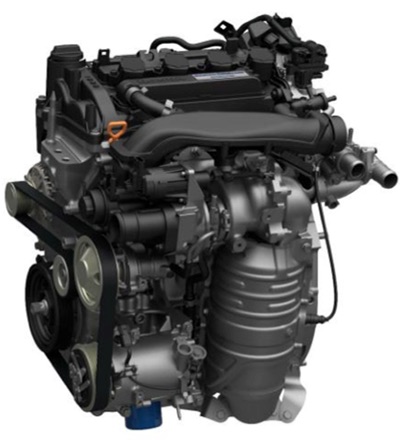
The turbocharged 1.5-liter engine is rated at 174 horsepower at 5,500 rpm3 with 162 lb.-ft of torque between 1,800 and 5,500 rpm.4 The Civic Turbo is anticipated to be rated by the EPA at 31/42/35 mpg.6

See the 1.5 L Turbo engine animation for a visual representation of prominent engine features and functions.
Cylinder Block and Crankshaft
The Civic's new
1.5-liter inline four has a lightweight die-cast aluminum block with
individual reinforced main bearing caps to minimize weight. Cast-in iron
cylinder liners provide long-lasting durability. Each journal on the
lightweight forged-steel crankshaft is micropolished to reduce internal
friction.
Pistons and Connecting Rods
The 1.5-liter engine's
pistons help maintain stable combustion and contribute to improved
efficiency with "cavity-shaped" crowns. The lightweight pistons have a
carefully optimized skirt design to minimize reciprocating weight, which
minimizes vibration and increases operating efficiency. The pistons are
cooled by twin oil jets directed at the underside of each piston crown.
Ion-plated piston rings help reduce friction for greater operating
efficiency. Lightweight, high-strength steel connecting rods are
heat-forged in one piece and then "crack separated" to create a lighter and
stronger rod with an optimally fitted bearing cap.
Cylinder Head and Valvetrain
The direct-injected
Civic 4-cylinder turbocharged engine has a lightweight DOHC cylinder head
that is made of pressure-cast aluminum alloy. With exhaust port cast
directly into the cylinder head, the need for a traditional separate
exhaust manifold is eliminated.
A low-friction, silent-chain drives dual overhead cams and four valves per cylinder. The cam drive is maintenance free throughout the life of the engine. To help further reduce weight, new thin-wall hollow camshafts are used.
To benefit fuel efficiency, emissions and power, the turbo engine utilizes sodium filled exhaust valves. A hollow chamber within the valve contains sodium that is cooled by the exhaust port cooling jacket. As the camber reaches close to the valve head, the sodium helps to cool the entire valve. As the valve is internally cooled it doesn't need the enriched fuel mixture that was generally used in turbo engines to help cool the exhaust valve. The resultant leaner mixture reduces emissions, increases fuel efficiency and helps increase power.
The cylinder head includes smaller M12 sparkplugs, down from the more common M14, to save space and weight. The head also includes direct-injection multi-hole fuel injectors with a small diameter bore. Higher-pressure direct injection optimizes fuel atomization, allowing for more efficient combustion. To provide a high-tumble intake charge that further enhances combustion efficiency, both the intake port and piston crown have special designs.
The Civic Turbo engine features Variable Valve Timing Control (VTC) that can vary the timing of both the intake and exhaust camshafts independently. With the turbo engine's variable cam timing, the cam timing can be optimized to suit the driving conditions. Under light loads, valve overlap can be increased to reduce pumping losses and improve fuel efficiency. When engine speed is low and engine load is large, such as during initial acceleration, the amount of overlap is increased to boost the scavenging effect, which improves torque and responsiveness. When engine speed is high and engine load is also high, such as during full-throttle acceleration, the amount of valve overlap is reduced to increase engine output by improving both intake and scavenging.
Direct Injection System
The direct-injection system
enables increased torque across the engine's full operating range along
with higher fuel efficiency. The system features a compact, high-pressure,
direct-injection pump that allows both high fuel flow and pulsation
suppression, while variable pressure control optimizes injector operation.
A multi-hole injector delivers fuel directly into each cylinder (not to the
intake port, as in conventional port fuel injection designs), allowing for
more efficient combustion.
The multi-hole injectors can create the ideal stoichiometric fuel/air mixture in the cylinders for good emissions control. Theoretically, a stoichiometric mixture has just enough air to completely burn the available fuel. Based on the operating conditions, the direct-injection system alters its function for best performance. Upon cold engine startup, fuel is injected into the cylinders on the compression stroke. This creates a weak stratified charge effect that improves engine start-up and reduces exhaust emissions before a normal operating temperature is reached.
Once the engine is fully warmed up, for maximum power and fuel efficiency fuel is injected during the intake stroke. This helps create a more homogeneous fuel/air mix in the cylinder that is aided by the high-tumble intake port design. This improves volumetric efficiency, and the cooling effect of the incoming fuel improves anti-knock performance.
Low Inertia Mono Scroll Turbo System with Electric Wastegate
The turbocharged Civic engine employs a small-diameter turbine for
maximum responsiveness. The Mono scroll housing design helps the turbo
build boost even at relatively small throttle openings and low rpm. The
electrically actuated wastegate allows boost pressure to be precisely
controlled.

A large air low-restriction intercooler is positioned low in the front of the car where it receives unobstructed airflow when the vehicle is in motion. Intake air travels from the air filter, to the turbo compressor, on to the intercooler, then to the engine's intake ports. The intercooler helps reduce the temperature of air entering the engine, making it denser for greater performance. To reduce weight, the turbo system is plumbed with rigid, lightweight resin composite inlet pipes to carry intake air to and from the intercooler.
Common Engine Features
ECON
Mode
Every 2016 Civic is equipped with a green ECON button
located on the center console near the shift lever. When the button is
pushed to activate ECON mode, several operating characteristics of the
vehicle are modified for enhanced fuel efficiency. The Drive-by-Wire
throttle system provides more gradual response, and to save additional
energy, the climate control's fan speeds are lowered incrementally and
other climate control system characteristics are altered based on the
conditions. Another push of the ECON button reverts all systems to their
normal mode.

Friction Reducing Technology
Both of Civic's
engines make use of new friction-reducing technologies designed to improve
engine efficiency. The outer skirts of lightweight aluminum pistons feature
a low-friction coating applied in a unique pattern application. The result
is reduced overall friction as the pistons move within the cylinder bores.
Plateau honing further lowers the friction level between the pistons and
the cylinders by creating an ultra-smooth surface. Plateau honing is a
2-stage machining process that uses two grinding processes instead of the
more conventional single honing process. This also enhances the long-term
wear characteristics of the engine. Low viscosity oil (0W-20) also reduces
friction. Other contributors to overall operating efficiency are a special
two-stage oil pump relief valve, low-friction oil seals, special low-drag
piston ring design, low-friction cam chain and a lightweight
crankshaft.
Drive-by-Wire Throttle System
The Civic's
Drive-by-Wire throttle system replaces a conventional throttle cable with
smart electronics that "connect" the accelerator pedal to a throttle valve
inside the throttle body. The result is less under-hood clutter and lower
weight, as well as quicker and more accurate throttle actuation. Plus, a
specially programmed "gain" rate between the throttle pedal and engine
offers improved drivability and optimized engine response to suit specific
driving conditions.
Honda's Drive-by-Wire throttle system evaluates the current driving conditions by monitoring throttle pedal position, throttle valve position, engine speed (rpm) and road speed. This information is used to define the throttle control sensitivity that gives the Civic's throttle pedal a predictable and responsive feel that meets driver expectations.
Emissions Control
Both 2016 Civic engines meet the
tough EPA LEV3-ULEV125/LEV3-SULEV30 emissions standards,5 and
are certified to this level of emissions performance for 120,000 miles.
100,000+/- Mile Tune-up Intervals
The Civic's
powerplant requires no scheduled maintenance for 100,000+/- miles or
more8, other than periodic inspections and normal fluid and
filter replacements. The first tune-up includes water pump inspection,
valve adjustment, and the installation of new spark plugs.
Maintenance Minder™ System
To eliminate
unnecessary service stops while ensuring that the vehicle is properly
maintained, the Civic has a Maintenance Minder™ system that
continually monitors the vehicle's operating condition. When maintenance is
required, the driver is alerted via a message on the Multi-Information
Display (MID) on the LX trim or Driver Information Interface (DII) on EX
and above trims. (See
the Interior Section for more information about the DII).
The Maintenance Minder™ system monitors operating conditions such as oil and coolant temperature along with engine speed to determine the proper service intervals. Depending on operating conditions, oil change intervals can be extended to a maximum of 10,000 miles, potentially sparing the owner considerable expense and inconvenience over the life of the vehicle. The owner-resettable system monitors all normal service parts and systems, including oil and filter, tire rotation, air-cleaner, transmission fluid, spark plugs, coolant, brake pads and more. To reduce the potential for driver distraction, maintenance alerts are presented on the DII only when the ignition is first turned on, not while driving.
Advanced Transmissions
Continuously Variable Transmissions (CVT)
Two
different CVT transmissions are offered in the new Civic to best suit the
power output and operating characteristics of each available engine. Both
Continuously Variable Transmissions (CVT) offer smooth and predictable gear
ratio transitions and excellent acceleration matched with efficient low-rpm
cruising. A wide ratio spread results in strong acceleration performance
coupled with reduced engine rpm at high road speeds.
Each CVT is comprised of an engine driven torque converter that in turn drives two variable-width pulleys connected by a steel belt. With its angled inner faces, the belt can circle the angled pulley faces at varying diameter depending on the pulley width, which alters the effective ratio between the pulleys. Since there are no steps in the pulley faces, the range of possible gear ratios is essentially infinite. This ultra-fine control of the gear ratio is the key to the CVT's greater efficiency over a conventional automatic transmission with a limited number of discrete gear ratios. Instead of approximating the correct ratio for the conditions like a conventional automatic does, the Civic CVTs can precisely select the optimum ratio from moment to moment without steps or slippage. Computer control of the transmission allows the ratio between the pulleys to be altered almost instantly to best suit the driving conditions and accelerator pedal setting.

Continuously Variable Transmission for 2.0L i-VTEC
The Civic LX and EX which are powered by the 2.0-liter engine offer a CVT
(available in the LX and standard in the EX) that is a refined version of
the CVT that was offered in the previous generation Civic. It features a
retuned torque converter, and a new generation of G-Design shift
logic.
Continuously Variable Transmission for 1.5L Turbo
Turbo Civic models offer a CVT that is an evolution of the CVT transmission
that is offered in Accord 4-cylinder models. In this application, the
transmission's final gear ratio is 4.69-percent taller than the Accord CVT
on which it's based, to allow for lower engine rpm while cruising. A new
generation of G-Design shift logic aids acceleration and has a more
familiar driving feel. A new turbine twin-damper design for the torque
converter provides tighter control and helps reduce turbocharger lag as the
vehicle accelerates.
CVT Common Features
G-Design Shift Feature
Both
available Civic CVTs are designed to provide the optimum gear ratio for the
driving conditions, and to offer a more natural driving feel than some
previous CVT transmissions that may have something of a disconnected
"rubber-band" feel compared to a conventional automatic transmission.
The Civic CVTs have a new generation of special G-design shift logic that is designed to offer more immediate acceleration response than either conventional automatics or other CVT designs. When abruptly applying power from a steady-state cruising speed, both Civic CVTs immediately send power to the drive wheels while simultaneously adjusting the gear ratio (seamlessly and progressively downshifting) to smoothly bring the engine to its horsepower peak in a linear way.
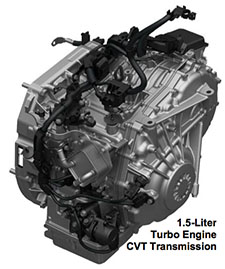
By comparison, a conventional automatic is slower to respond and loses time making multiple downshifts. Since the automatic transmission has a limited number of separate, discrete ratios, even when fully downshifted, it can only approximate the optimum engine rpm as speed increases. This cuts into acceleration.
During full throttle acceleration, the new generation of G-Design shift logic employs stepped ratios as the vehicle speed increases. This helps give the transmission a more "connected" feel as the engine rpm and vehicle speed increase together. This stepped operation also improves acceleration performance incrementally.
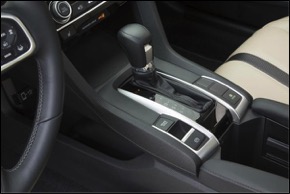
CVT Automatic Modes
The transmission can be
operated in three different fully automatic forward modes with the
console-mounted straight-gate shifter. The D mode is ideal for most driving
situations, and combines fuel efficiency with smooth operation and
responsive power when needed. The S mode is for more performance-oriented
driving, and features more aggressive transmission mapping to keep engine
rpm higher for greater acceleration and response. The L mode is ideal for
situations when additional engine braking is desired, such as in
mountainous driving.
S-Range Control
To allow the driver to alter the
operation of the CVT, the console-mounted gear selector includes an "S" or
Sport mode that provides a sport-shift schedule that delays upshifting for
more available power, and provides greater engine braking.
6-Speed Manual Transmission
A 6-speed manual
transmission (6MT) is standard on the Civic LX. The unit offers smooth and
precise shift feel and great efficiency. Compared to the 5-speed manual
transmission it replaces in the Civic, the 6-speed transmission has been
carefully engineered to deliver state-of-the-art performance and shift
action, with reduced internal friction, tighter internal tolerances and
improved synchronizers. The transmission also has a more rigid aluminum
exterior case, higher-capacity ball bearings, stiffer gear shafts, and
greater torque capacity. Refinements to the shift linkage and selector
mechanism produce a precise and smooth gear lever shift action. A new
constant-mesh helical reverse gear mechanism significantly reduces noise
when reverse is selected. A reverse lockout feature prevents the
transmission from accidentally being shifted into reverse while the car is
moving forward.
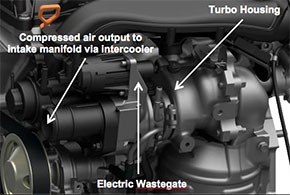
Manual Transmission Gear Ratio Comparison
|
Gear Ratio (X:1) |
2015 Civic 1.8L |
2016 Civic 2.0L |
|
1st |
3.143 |
3.642 |
|
2nd |
1.870 |
2.080 |
|
3rd |
1.235 |
1.361 |
|
4th |
0.949 |
1.023 |
|
5th |
0.727 |
0.829 |
|
6th |
— |
0.686 |
|
Reverse |
3.308 |
3.673 |
|
Final Reduction Ratio |
4.290 |
4.105 |
Continuously Variable Transmission Gear Ratio Comparison
|
Gear Ratio (X:1) |
2015 Civic 1.8L |
2016 Civic 2.0L |
2016 Civic 1.5L T |
|
Forward |
3.200~0.517 |
2.526~0.408 |
2.645~0.405 |
|
Reverse |
3.428~0.554 |
2.706~1.552 |
2.645~1.800 |
|
Final Reduction Ratio |
3.940 |
4.680 |
4.811 |
Powertrain Feature Comparison
|
Feature |
2016 Civic 2.0L |
2016 Civic 1.5L T |
|
Engine Type |
L-4 |
L-4 Turbocharged |
|
Displacement (cc) |
1996cc |
1496cc |
|
Horsepower @ rpm |
158 @ 65001 |
174 @ 55003 |
|
Torque |
138 @ 42002 |
162 @ 1800-5500 (CVT)4 |
|
Bore and Stroke (mm) |
86 x 85.9 |
73 x 89.4 |
|
Compression Ratio |
10.8:1 |
10.6:1 |
|
Fuel Injection |
Port |
Direct |
|
Programmed Fuel Injection (PGM-FI) |
• |
|
|
Valvetrain |
16-Valve DOHC i-VTEC® |
16-Valve DOHC w/VTC |
|
Drive-by-Wire Throttle System |
• |
• |
|
Low-Inertia MONO Turbocharger |
|
• |
|
Variable Intake Valve Lift |
• |
|
|
Intake/Exhaust Variable Cam Timing |
• |
• |
|
Feature (cont.) |
2016 Civic 2.0L |
2016 Civic 1.5L T |
|
Transmission |
6-Speed Manual / CVT |
CVT |
|
Front Wheel Drive |
• |
• |
|
Hill Start Assist |
• |
• |
|
100K +/- Miles No Scheduled Tune-Ups7 |
• |
• |
Fuel Economy and Emissions Ratings
|
Ratings |
2016 Civic 2.0L |
2016 Civic 1.5L T |
|
EPA Fuel Economy Ratings6 (city / highway/ combined) (anticipated) |
27/40/31 (6MT) |
31/42/35 (CVT) |
|
Recommended fuel |
Regular unleaded 87 octane |
Regular unleaded 87 octane |
|
CARB emissions rating5 |
LEV3-ULEV125/LEV3-SULEV30 |
LEV3-ULEV125/LEV3-SULEV30 |
(See the Specifications and Features section for all data.)
1 158 horsepower @ 6500 rpm (SAE net)
2 138 lb-ft @4200 rpm (SAE net)
3 174 horsepower @ 5500 rpm (SAE net)
4 162 lb-ft @ 1800-5500 rpm (SAE net)
5 CVT models are LEV3-SULEV30-rated in California and states that have adopted California vehicle emission regulations. CVT models in non-CARB states and 6MT models in all 50 states are LEV3-ULEV125-rated.
6 Preliminary mileage ratings determined by Honda. Final 2016 EPA fuel-economy ratings not available at the time of printing. Use for comparison purposes only. Your mileage will vary depending on how you drive and maintain your vehicle, driving conditions and other factors.
7 Does not apply to fluid and filter changes. Will vary with driving conditions. Please see your Honda dealer for details.
The Most In-Depth Honda Vehicle Shopper's Research - Anywhere!


